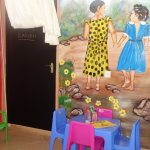I recently stopped by the child-friendly room to admire the wonderful work done by the artist who decorated the walls of the Gender Based Violence Recovery Centre (GBVRC) at the Rift Valley Provincial General Hospital in Nakuru.
In an adjacent waiting room, a toddler was crying and fussing, waiting to be seen by a clinician. He escaped his mother’s grasp and ran by me. Just as I opened the door to the room, he stopped mid-cry and his eyes lit up at the sight of the walls and colors! He turned to me excitedly and asked if he could sit in the room and play with the toys. This was the exact reaction that we had hoped the child-friendly space would elicit from the children seeking care and treatment at the GBVRC!
Sexual violence is a significant problem in Kenya that cuts across gender, geographical locations, economic status, and age. According to the Kenyan Demographic and Health Survey of 2014, 14 percent of women aged between 15 years and 49 years reported that they were victims of sexual violence. Statistics also show that in 2013, the Kenya National Police Service received 3596 cases of sexual violence meted upon children. These numbers have steadily increased in recent years.
Child survivors of sexual violence require unique care. At Rift Valley Provincial General Hospital, where nearly half of the survivors who showed up at the GBVRC in 2018 were under 17 years of age, Physicians for Human Rights works closely with the staff to ensure that they have the necessary knowledge, skills, and resources to attend to this vulnerable demographic.
It’s part of a two-year partnership with the Nakuru County Department of Health to improve Rift Valley Provincial General Hospital’s post-rape care, including building capacity for medical-legal examinations, evidence collection and documentation, and the provision of comprehensive care to survivors of sexual violence. By turning the hospital into a county-wide center of excellence, we and our partners are investing in our ultimate goal: increasing access to justice for survivors.
For many survivors, there are huge barriers to seeking care for sexual violence, let alone pursuing justice. The stigma that comes with being a survivor often deters people from reporting and seeking healthcare. If a survivor does manage to overcome this, they may then be forced to deal with untrained service providers and further risk re-traumatization. For the youngest children, there is also the fear that through collusion and the exchange of money, the case may be settled at the community level, without the child receiving appropriate care and access to justice.
We and our partners at Nakuru worked hard to identify and address any barriers to care and treatment faced by survivors, all the while focusing on a survivor-centered approach: one that recognizes that each survivor has different needs and will require different resources and approaches to treatment and follow-up care.
With input from our medical experts, we set out to establish a safe and inclusive space that would provide a nurturing environment for vulnerable and at-risk children to access treatment and follow-up care. We wanted a setting that would support the recovery of children through structured activities conducted in a safe and stimulating environment, and that would facilitate their referral to other steps along the chain of justice, such as police, mental health, and legal aid professionals. Most importantly, we wanted to create a space for children to play and engage in other creative activities as a form of therapy to help them express and communicate their feelings.
We also embarked on a three-month training period for staff – many of whom had received prior training from PHR – that included a session on responding to child survivors of sexual violence. We worked with the hospital to develop a set of best practices for their systems and procedures. One of these protocols* was designed to guide their responses to vulnerable populations – specifically children and adolescents. Finally, we looked at how to make the space function effectively and efficiently. One easy fix: stock it with supplies like stationary, toys, books, and other educational materials.
To further enrich the utility of the child-friendly space, PHR connected hospital staff with various child-protection partners in Nakuru County who would provide increased expertise for child therapy, supervision for the staff at the facility, clarity on reporting structures for minors, and a robust referral directory for child/adolescent needs.
Since its launch, the child-friendly space has received about 80 young patients. Our partners say that having this dedicated space has definitely had an impact on the experiences that the young survivors have when receiving treatment and counselling – most don’t want to leave! Combined with the knowledge the staff have gained, the room is drastically shifting the paradigm on what it means to offer post-rape care services to children in the region.
All the effort and thought we put into this process was definitely worth it. This became very clear to me when that young boy with teary eyes smiled up at me, as I welcomed him into the room.
*Special Considerations for Vulnerable Populations – Children and Adolescents

